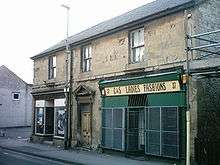Kippax, West Yorkshire
| Kippax | |
 Kippax High Street |
|
 Kippax |
|
| Population | 21,116 (Ward. Kippax and Methley. 2011) |
|---|---|
| Civil parish | Kippax |
| Metropolitan borough | City of Leeds |
| Metropolitan county | West Yorkshire |
| Region | Yorkshire and the Humber |
| Country | England |
| Sovereign state | United Kingdom |
| Post town | LEEDS |
| Postcode district | LS25 |
| Police | West Yorkshire |
| Fire | West Yorkshire |
| Ambulance | Yorkshire |
| EU Parliament | Yorkshire and the Humber |
| UK Parliament | Elmet and Rothwell |
Coordinates: 53°46′01″N 1°22′14″W / 53.7669°N 1.3705°W
Kippax is a village and civil parish in the City of Leeds metropolitan borough, West Yorkshire, England. It is situated to the east of the city, near to Garforth and Great Preston. The Kippax and Methley ward of Leeds City Council was part of the former UK Parliament constituency of Elmet, which became Elmet and Rothwell at the 2010 UK general election.[1] The population of the Kippax and Methley ward at the 2011 Census was 21,116.[2] Kippax was a separate civil parish, in Tadcaster Rural District, until 1939, when it was annexed to Garforth. It re-acquired civil parish status and a parish council on 1 April 2004.
History
The name Kippax is of Anglo-Saxon origin and is first attested as Chipesch in the Domesday Book of 1086, and as "Kippeys" in charters from the 1090s to the 1270s, and Kypask and Kypax from the 13th century onwards. The placename seems to be composed of an Anglo-Saxon personal name Cippa (with initial [tʃ-], suggested by the Domesday Book form) or Cyppa (with initial [k-]) + æsc [æʃ] 'ash-tree'. This suggests that the village was first established in a wooded area of ash trees. The pronunciation of the name seems to show Scandinavian influence, perhaps in the change from initial [tʃ-] to [k-], and more clearly in the change of [-æʃ] to [-ask] (and thereafter [-aks]).[3]
Locational surnames such as Kippax developed when former inhabitants of a place moved to another area, usually to seek work, and were best identified by the name of their birthplace. The surname first appears in the late-14th century and other early recordings include: Johannes de Kypax, Johanna Kepas, and Johannes de Kepax, who were all recorded in the Poll Tax Records of Yorkshire in 1379.[4]
The village's historical roots are evidenced by the presence of an originally Anglo-Saxon church which underwent significant modification in Norman times.[5] Typical Saxon herring-bone masonry can be seen in the church tower. Despite being an administrative centre for hundreds of years, the population remained small and it was mostly agricultural until the late-18th century when coal mining began on a small scale in bell pits. The advent of deeper mining and the discovery of coal seams in Allerton Bywater saw Kippax undergo a rapid expansion into a typical northern mining community in the 19th century. The decline in deep mining saw Allerton Bywater pit close in the 1990s having been in decline since the 1970s.
Kippax adjusted to its new status as a commuter village. Its proximity to the A1/M1/M62 means that many residents now commute to Leeds, Castleford, London, Wakefield or York rather than working locally. Its old identity as a "mining community" lives on with the village's older residents. This identity could be lost if Kippax becomes part of the greater urban sprawl of east Leeds. Housing development between Kippax and its neighbours (Swillington, Garforth, Great Preston, Allerton Bywater) over the last ten years has reduced Kippax's green margins and its village status will soon be questionable. The high street has a mix of independent butchers, grocers and newsagents and a small co-op store.
Kippax village centre

As a neighbourhood shopping area, Kippax High Street is undergoing a resurgence with all available shops and premises now occupied. However there are two eyesores which blight the appeal of this welcoming High Street and both could benefit from intervention to bring them back as attractive and effective offers. As Kippax and neighbouring villages comprise a reasonable population, (approximately 18,000 people), the High Street could become a vibrant hub if some basic attention is provided. In 2009, local hero Bryan Higgins walked 100,000 steps around the village and a significant amount of money was raised by the community in aid of the Roy Castle Trust.[6]
Gallery
 The Old Tree Inn
The Old Tree Inn The White Swan
The White Swan The Royal Oak
The Royal Oak Kippax Library
Kippax Library Co-op
Co-op Central Fisheries with its distinctive mural
Central Fisheries with its distinctive mural The Moorgate
The Moorgate Fishing ponds in Kippax
Fishing ponds in Kippax
Location grid
 |
Garforth |  | ||
| Swillington | |
Ledsham | ||
| ||||
| | ||||
| Allerton Bywater |
References
- ↑ "ukpollingreport.co.uk » Elmet and Rothwell". ukpollingreport.co.uk. Retrieved 2009-12-06.
- ↑ "City of Leeds ward population 2011". Neighbourhood Statistics. Office for National Statistics. Retrieved 28 February 2016.
- ↑ Victor Watts (ed.), The Cambridge Dictionary of English Place-Names, Based on the Collections of the English Place-Name Society (Cambridge: Cambridge University Press, 2004), s.v. KIPPAX.
- ↑ "Surname Database: Kippax Last Name Origin". 2012. Retrieved 22 April 2012.
- ↑ "GENUKI: Kippax". www.genuki.org.uk. Retrieved 2009-12-06.
- ↑ "Kippax man gets set for 100,000 steps charity challenge - Kippax Today". www.kippaxtoday.co.uk. Retrieved 2011-01-11.
External links
| Wikimedia Commons has media related to Kippax, West Yorkshire. |
- Kippax Village
- YEP Kippax Today Community Website
- "The Ancient Parish of Kippax". GENUKI. Retrieved 2007-10-29.